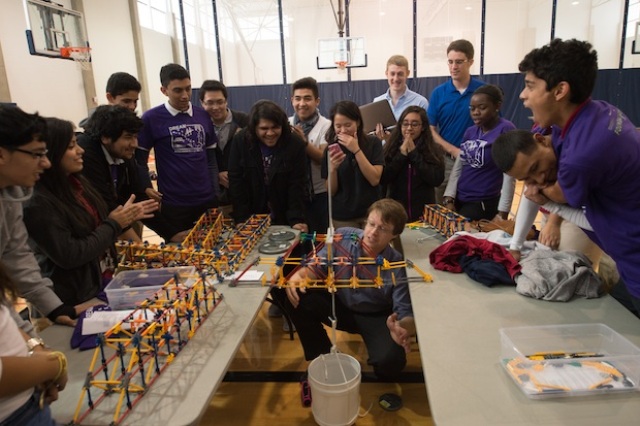Nov 17 2014
Bridges to college get a little stronger for students challenged to build them for themselves.
Seventy-five Houston middle- and high school students accepted that task at Rice University Nov. 12 when they came to campus for the first of three DREAM Design Challenges this academic year.
 Brent Houchens stresses a K'nex bridge to the max during the DREAM Design Challenge at Rice University. The program matches mentors with high school and middle school students to encourage them along the path to science, technology, engineering and mathematics careers. Photo by Jeff Fitlow
Brent Houchens stresses a K'nex bridge to the max during the DREAM Design Challenge at Rice University. The program matches mentors with high school and middle school students to encourage them along the path to science, technology, engineering and mathematics careers. Photo by Jeff Fitlow
DREAM matches Rice student mentors and alumnae mentors with K-12 mentees at Houston-area secondary schools to help them prepare for the more advanced challenges of a STEM (science, technology, engineering and mathematics) college education. The goal is to increase the number of underrepresented minority students who earn undergraduate degrees in STEM disciplines, especially engineering.
The program primarily takes place at the schools, where Rice mentors work once a week with groups of up to five students. The DREAM Design Challenges offer the enthusiastic youngsters a chance to come to Rice three times each year to put what they’ve learned to the test.
For the 2014-15 academic year’s first DREAM Design Challenge, teams of grades 7-12 students from KIPP Houston High School and the Houston Independent School District’s Young Women’s College Preparatory Academy prebuilt K’nex bridge components to standards set by their Rice mentors and program directors. They brought the modules to Rice’s Gibbs Recreation and Wellness Center, where their mentors helped them tweak and complete their bridges for testing.
“The bridges are judged on how much mass they can support, the distance they span, the width of the bridge at the minimum point — which determines how much traffic can go across — and the mass of the bridge itself,” said Brent Houchens, who started DREAM while teaching at Rice in 2006.
Houchens and the mentors tested the completed bridges by increasing the weight hanging from a center point until each structure failed. The students watched anxiously as their bridges took the strain as much as possible before collapsing to the floor.
Moises Mendoza, a senior at KIPP, said his team’s robust bridge required all of their physics and calculus knowledge. “Our initial design was very weak,” he said. “Although we implemented a strong center, we noticed the sides that were placed on the table had a lot to do with holding the mass.” Ultimately, the span supported an impressive 14.5 pounds before tumbling.
DREAM program challenges middle and high schoolers to pursue engineering education
“This program does more than just solve physics problems or math problems that we do in class,” he said of DREAM. “It makes us incorporate our knowledge into the actual engineering world. It’s not like getting a word problem and solving it. We have to figure out how things work in the real world.”
Rice’s student mentors, who commit to the project for at least one semester, get just as much satisfaction from DREAM as their mentees.
“It was a perfect way to apply my passion for volunteering,” said Chloe Nguyen, a senior bioengineering student and a head mentor. “I liked the idea of the STEM focus, so I got to take my education, which is essentially for my own benefit, and turn it around and focus on someone else’s betterment.”
Nguyen has been working with students at Chavez High School in southeast Houston since her sophomore year, as well as helping with the logistics for about 60 other student volunteers. “Our mentees get the experience of not only applying their physics knowledge but also working in teams and getting to see what actual engineering is like, as opposed to reading about it,” she said. “The goal is to let them see they can be engineers too.”